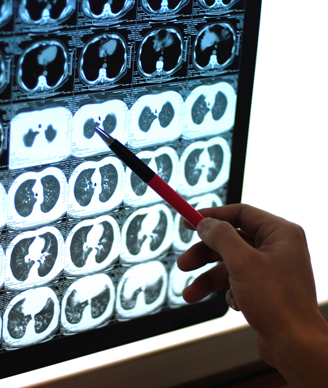Lung-RADS Reduces False Positives, Sensitivity of Lung Screening
A classification system known as Lung-RADS reduced false positive rates but also decreased the sensitivity of low-dose CT screening compared with NLST standards.
Lung-RADS reduced false positive rates, but at a cost of decreased sensitivity; image © bendao/Shutterstock.com

A classification system known as Lung-RADS offers reduced false positive rates but also decreased sensitivity in low-dose computed tomography (LDCT) lung screening compared to standards used in the National Lung Screening Trial (NLST), according to a new study. Further study is still needed to determine if lung-RADS should be incorporated into daily practice.
“Much knowledge has accumulated since the NLST was designed in 2002,” wrote researchers led by Paul F. Pinsky, PhD, of the National Cancer Institute in Bethesda, Maryland. In the NLST, a positive screening result was a nodule of 4 mm or greater; recent research has suggested that increasing that cutoff to 6 or 8 mm would have reduced the false positive rates substantially, while only slightly decreasing sensitivity. That along with other accumulating data led to the American College of Radiology’s Lung-RADS classification system, which scores patients based on nodule presence, size, and suspicion of malignancy on a scale from 1 through 4X.
The new study applied that system to the NLST cohort itself retrospectively to test its efficacy. It included 26,455 patients in the LDCT group of the trial who received a baseline screen; 48,671 screens were done after baseline. Results were published online ahead of print in the Annals of Internal Medicine.
At the baseline screen, the false positive rate for Lung-RADS was 12.8%, vs 26.6% for the NLST guidelines. In subsequent screens, the false positive rate remained far lower with Lung-RADS, at 5.3% vs 21.8% for the NLST.
Sensitivity, however, suffered with Lung-RADS classification. Baseline sensitivity was 84.9% with Lung-RADS vs 93.5% with NLST, and sensitivity after baseline was 78.6% for Lung-RADS and 93.8% for NLST. Of the 649 true-positive cancer cases according to NLST criteria, 86 (13%) were missed with Lung-RADS; 25 of those were missed at baseline, and 61 on subsequent screens.
“Using Lung-RADS … has the potential to substantially reduce the burden of LDCT screening,” the authors wrote. “A critical question, however, is how the corresponding sensitivity reduction might affect the mortality benefit of LDCT screening.” They noted that this was a retrospective analysis, and that prospective data will allow revisions to the classification system that may increase sensitivity.
“The potential effect of reduced sensitivity on the mortality benefit of LDCT screening is unknown,” they concluded. “Further validation with prospective data collection will be necessary going forward.”